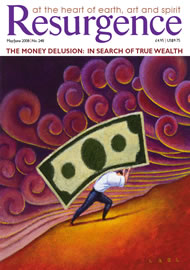It seems to me I have always loved walking in the dark. More especially, at dusk; walking through from one day’s end to the growing stage of the next. Night doesn’t ‘fall’; nothing so abrupt and graceless: as Macbeth observed, light thickens, so that for an instant colours flare against the retina, then fade. Shadows clot into a vagueness so that things are seen clearer out of the corner of the eye. At last only pale objects beckon; an outcrop of white limestone snags the glance, a new lamb glimmers, tucked in under an earth bank; petals drift soundlessly from a hedgerow rose. Sometimes – particularly on calm summer evenings when the air is cool silk on bare arms – it seems darkness seeps up through the ground, as if easing an aquifer, an ancient core of black wrapped within the rock since the Earth’s first cataclysms. It is a transformation we fail to appreciate only because it takes place so predictably, so often in a lifetime. We do not even notice it any more.
In winter it happens early and surprisingly quickly. I take a path my feet know well, up our sheep field behind the house, scramble over a stile and then through gorse and rough pasture past the last cottage.
As the twilight deepens, things become first dark shapes, then outlines, and are absorbed, as if in a metaphor of all living matter. And the thickening air accepts the human walker too, takes you into itself so that, far from other people’s torches and fuss, you move with as well as through the night. There’s an occasional rustle in the hawthorn as a bird tucks its head in, a whisper of dry grass that betrays a rabbit or a hedgehog’s purposeful tread, but otherwise a settling into quiet. Soon enough, though, car headlamps – two, three, as if racing each other – will leap up and over the fields, there’ll be a scattering of houselights and, far below, the chapel windows glow, like long yellow lozenges, for a meeting of Merched y Wawr (the Welsh Women’s Institute) or an after-school practice for the Spring Eisteddfod. And then down the road home, the old dog and I padding round to the back door, throwing it open to a blare of bright noise and the smell of baking potatoes. They look up – whoever’s there – stupid with warmth and television news, and I feel an intruder, too big for the room, more real, charged. Fully alive.
The habit of walking in the dark started when I was ten or eleven years old and circumstances forced my family to live perched above the Calder valley in the Pennines. A cart track twisted steeply up through fields to our house; then there were straggly woods and a gate onto the moor, miles of its dark pelt rolling over the rim of the horizon past wild, witchy Whirlaw Rocks and beyond Stoodley Pike to Crow Hill and Top Withens. A huge sky, blowing bog-cotton and forgotten Roman roads among the heather, dead farms that stared out over mill towns sunk under their own smoke. It was a harsh landscape but I knew it, first out of necessity, then with a growing sense of connection.
Our home life was fractured, makeshift: my little sister turned to animals for love and companionship while I found satisfaction in landscape and then literature about landscape. I learned the shapes of the hills against the sky, the slow-motion gestures of trees, the clouds and changing colours in the sky that would “move all together if it move at all” (we ‘did’ Wordsworth at school) and I longed to be part of that unity. Walking at night, I found, was a good way of losing self-consciousness, or perhaps having the space to be more yourself. Because other children, and even adults, were afraid of the dark, it lent a feeling of power, too.
We lived remote from other houses; until I lived in cities and travelled through them I was never afraid of what I might encounter. These were not great expeditions, you understand: just going from place to lighted place – walking home from school in winter, or after babysitting for Dorinda in the council houses. Running down to the farm because the milk in its white enamel billycan had been forgotten on the wall, or slipping out to look for badgers at full moon. The childless couple at Rake Hey Farm had a television and would sometimes invite me to watch Russ Conway playing the piano, or a quiz show: after an evening sitting in the middle on their lumpy sofa I’d feel the smell of horses streaming off me in the cool night wind, and my dreams would be wild with cantering and whinnies.
In Her Element: Women and the Landscape, edited by Jane MacNamee, is published by Honno Gwasg Menywod Cymru/Welsh Women’s Press. www.honno.co.uk







